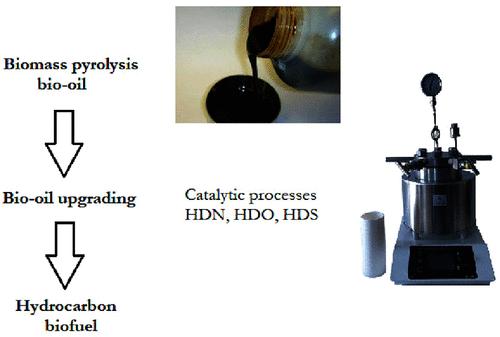当前位置:
X-MOL 学术
›
Ind. Eng. Chem. Res.
›
论文详情
Our official English website, www.x-mol.net, welcomes your feedback! (Note: you will need to create a separate account there.)
Progress and Perspectives in the Catalytic Hydrotreatment of Bio-Oils: Effect of the Nature of the Metal Catalyst
Industrial & Engineering Chemistry Research ( IF 3.8 ) Pub Date : 2024-06-26 , DOI: 10.1021/acs.iecr.4c00747 A. Gil 1 , I. Sancho-Sanz 1 , S. A. Korili 1
Industrial & Engineering Chemistry Research ( IF 3.8 ) Pub Date : 2024-06-26 , DOI: 10.1021/acs.iecr.4c00747 A. Gil 1 , I. Sancho-Sanz 1 , S. A. Korili 1
Affiliation

|
In recent years, there has been a surge of interest in transforming biomass into fuel, driven by its potential as the only realistic renewable carbon resource. Several conversion methods have been explored to achieve this, including gasification for producing synthesis gas, fast pyrolysis or hydrothermal liquefaction for obtaining bio-oils, and hydrolysis for generating aqueous sugars. Bio-oils offer environmental benefits due to their lower CO2 emissions, but their direct use as fuels is hindered by limitations such as thermal instability, high viscosity and acidity, and low calorific value. Consequently, advancements in treatment methods are necessary before bio-oils can be used as direct fuels. This review focuses on the catalytic hydrotreatment of bio-oils, which has been shown to be an effective approach for the removal of heteroatoms at moderate temperatures (between 300 and 450 °C) but at high pressures (up to 20 MPa). Oxygenated compounds are transformed into H2O, and N and S are transformed into NH3 and H2S, respectively. The analysis examines how process temperature, residence time, hydrogen pressure, solvent selection, and type of catalyst influence the properties of the improved bio-oil. Mo/W sulfide-supported catalysts have been traditionally used as active phases in hydrotreatment processes, as the presence of S limits catalyst deactivation, while the presence of Ni or Co as promoters enhances hydrogenation reactions. New research trends are exploring alternative catalyst formulations, such as metal phosphides, carbides, nitrides, and mesoporous materials as supports with controlled acid-basic properties.
中文翻译:

生物油催化加氢处理的进展与展望:金属催化剂性质的影响
近年来,由于生物质作为唯一现实的可再生碳资源的潜力,人们对将生物质转化为燃料的兴趣激增。为了实现这一目标,已经探索了几种转化方法,包括气化生产合成气、快速热解或水热液化以获得生物油,以及水解产生含水糖。生物油由于其较低的二氧化碳排放量而具有环境效益,但其直接用作燃料受到热不稳定性、高粘度和酸度以及低热值等限制的阻碍。因此,在生物油可以用作直接燃料之前,必须改进处理方法。本综述重点关注生物油的催化加氢处理,该方法已被证明是在中等温度(300 至 450 °C 之间)、高压(高达 20 MPa)下去除杂原子的有效方法。含氧化合物转化为 H 2 O,N 和 S 分别转化为 NH 3 和 H 2 S。该分析检查了工艺温度、停留时间、氢气压力、溶剂选择和催化剂类型如何影响改良生物油的性能。 Mo/W硫化物负载的催化剂传统上用作加氢处理过程中的活性相,因为S的存在限制了催化剂失活,而Ni或Co作为促进剂的存在增强了加氢反应。新的研究趋势正在探索替代催化剂配方,例如金属磷化物、碳化物、氮化物和介孔材料作为具有受控酸碱特性的载体。
更新日期:2024-06-26
中文翻译:

生物油催化加氢处理的进展与展望:金属催化剂性质的影响
近年来,由于生物质作为唯一现实的可再生碳资源的潜力,人们对将生物质转化为燃料的兴趣激增。为了实现这一目标,已经探索了几种转化方法,包括气化生产合成气、快速热解或水热液化以获得生物油,以及水解产生含水糖。生物油由于其较低的二氧化碳排放量而具有环境效益,但其直接用作燃料受到热不稳定性、高粘度和酸度以及低热值等限制的阻碍。因此,在生物油可以用作直接燃料之前,必须改进处理方法。本综述重点关注生物油的催化加氢处理,该方法已被证明是在中等温度(300 至 450 °C 之间)、高压(高达 20 MPa)下去除杂原子的有效方法。含氧化合物转化为 H 2 O,N 和 S 分别转化为 NH 3 和 H 2 S。该分析检查了工艺温度、停留时间、氢气压力、溶剂选择和催化剂类型如何影响改良生物油的性能。 Mo/W硫化物负载的催化剂传统上用作加氢处理过程中的活性相,因为S的存在限制了催化剂失活,而Ni或Co作为促进剂的存在增强了加氢反应。新的研究趋势正在探索替代催化剂配方,例如金属磷化物、碳化物、氮化物和介孔材料作为具有受控酸碱特性的载体。











































 京公网安备 11010802027423号
京公网安备 11010802027423号